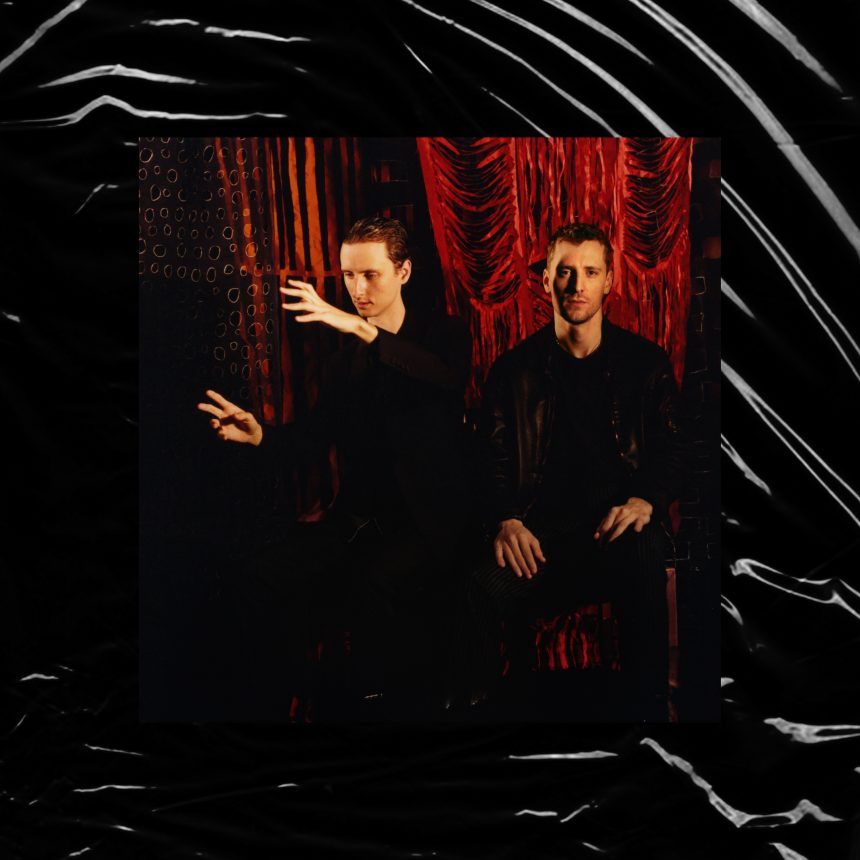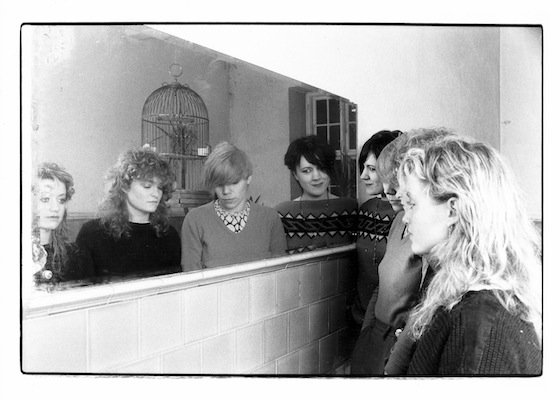These New Puritans – Music critique as an art form and the end of the world as compositional imperative

Essay by Macon Holt
“Critique is so limiting and emotionally draining. I have always wanted to do something long form, beyond opinion; dip my toe into an exploration of origin and essence; the metamorphosis of spirit into reality.” — Morf Vanderwalt, “Velvet Buzzsaw”
These New Puritans are a British band, formerly on Domino records, who initially garnered attention in 2006/7 as the arty-ist members of the, already insufferably arty, new rave genre. But even with their first record, “Beat Pyramid”, it was clear that the vision driving their project couldn’t be contained by the conventions of British post-punk. The band’s leader, vocalist Jack Barnett, seemed to be planning something that could only just be glimpsed through the cracks in his opaque lyrics (“ELVIS! I wasn’t talking about that king”), determined structural
Next week, These New Puritans’ fourth album, “Inside the Rose”, will be released and I feel utterly unequipped to review it. One reason for this may have something to do with the trivial notion that one needs to have some kind of distance to properly appraise a piece of art for the purposes of critique. And since I spent 2014 listening to their last album on repeat, I have completely collapsed that distance. Following the release of the first four tracks from the new record, however, I have been overcome with the urge to share my excitement about this music publicly, and with reviews out of the question, I felt completely impotent. I didn’t just want to blog about my excitement, I wanted to actually find some way to communicate it, to share it with other people. But that doesn’t seem to be what cultural journalism is for. It doesn’t seem to be my place to ecstatically express excitement. Such vulgarities should only be committed only by paid-off shills.
So then, I am left to wonder what is the place of the critic? And what is it we want from art if this sober detachment is what we want from our critics?
The quote above is from a caricature of an art critic played by Jake Gyllenhaal in the disappointingly ok film, “Velvet Buzzsaw” (2019). The film satirizes the vacuity of the high-end art world through the horrific violence inflicted by the spirit of a dead outsider artist, Vetril Dease, on those profiting from his work. The line is intended to highlight, Vanderwalt’s shallowness and pseudo-intellectualism. But there is a tension here because he says this while appraising a work by Dease, which, in the fiction of the film, we are meant to understand as being compelling and profoundly disturbing, yet beautiful, works of art.
So yes, while we can read in this quote that Vandewelt is shallow and self-serving, something honest is also being communicated; There are artworks that make the role of the critic seem irrelevant. And not just irrelevant but actually destructive. If everything is simply to be understood, in the terms laid down by the initiated, as being referentially linked to the canon of important works and measured in line with the assessments of these works by earlier critics and powerbrokers, then artworks themselves can end up disappearing in the act of appraising them. There is something vaguely nihilistic about this, as the standards by which we understand something to be good constantly appear to recede into the received opinions of authoritative others. Critique becomes about sectioning off reality in line with made-up yet fixed standards and disregarding the remainders that don’t fit. This can be fine and helpful, but when these standards don’t gel with your experiences, it can seem more like you’re trying to attain membership of a particular peculiar club rather than talking about the experience of a work of art. This can be emotionally draining.
What I mean by this is I can point out the conservatism of These New Puritans’ focus on orchestral instrumentation and arrangement, not to mention the relatively strophic song structures of the recent releases. I can recognize the problematic elements of the kind of white-male-genius-bravado-image they are peddling and the male gazei-ness (albeit filtered through the eyes of the director, Harley Weir) of their video for the song “Inside the Rose”. And while I think these assessments are partially correct, they say nothing of what the work does to me. The difficulty is, however, working out how to tell you why I think you should care.
Since the release of their last album, “Field of Reeds”, I have spent, perhaps, too much time in the possibility space their work produces in me. Their close and crisp recordings of orchestral instruments – becoming synthesizes becoming beats, becoming the snarling slurred absurdist vocals of Jack Barnett, becoming the vocals of classical singers – are given a sonic sheen that matches the revelatory aural experience that CD’s were promised to be in the late 80s and early 90s. A slice of a musical moment characterized by the releases of minimalist works by Philip Glass, Steve Reich and the film scores by Michael Nyman to the unsettling psychosexual art-house dramas of Peter Greenaway. This slice was itself situated amongst others, of course. There was also the beat-driven intensity of emerging strains of electronic dance music that permeated the zeitgeist, alongside the pop hits that shimmered so brightly that a great deal of their emptiness was obscured. And finally,
Among these are the ingredients of my first musical memories. While I can describe them here in these kinds of referential terms, the role these sounds play in my musical imaginary isn’t quite captured in these descriptions. Because, on some deep, difficult-to-escape level, these sounds make up what I believe music is meant to sound like. Since 2013, These New Puritans, a band whose two remaining members are roughly my age, have sounded exactly like this image of music. With the release of these first singles from the new record, it seems that they have somehow managed to sound even more like it.
It was this position, though in relation to different music and different musical imaginary, that lead Kodwo Eshun to invent the notion of “Sonic Fiction”. This was a way to understand the experience of music and to share it as something fundamentally additive and constructive. Music is not a puzzle to be solved according to a single system, but nor is it so unfathomable that we should insist “speak for itself”. Instead, in his book “More Brilliant Than The Sun”, Eshun wants to bring out “music’s mystifying illogicality is not chastised but systematized and intensified – into MythSciences that burst the edge of improbability, incites a proliferating series of
***
In a profile of the band ahead of the new release in Dazed Magazine, the apocalypse was used as a framing device to unpack the record. And from what I have heard so far, this frame holds. There is something doom-laden about this music. Something tragic but also the tragedy is fading as the systems that gave it meaning start to fall apart. “And I’ll never get up, Never give, Never get up, Never give up”. It feels as if, from some of the moments of music made available so far, this is a record intent on illustrating the difference between the tragedy inherent in death and the disappearance of this tragedy once the world comes to an end, and the sense of longing that makes it so easy to confuse the two.
The apocalypse has long been a theme identified with more experimental musical practices. There is even a book called “Drone and Apocalypse” that explores this in relation to drone music. There is more than a little to this interpretation. The inhuman sounds of this musical practice, which operates at volumes and durations that can make us, creatures with bodies, uncomfortable, can be a great way to come to some understanding of our position in an uncaring universe. And when practitioners such as Tim Hecker can bring beauty to this experience of self-disintegration, it can sure be a beguiling high to chase. But this is not what These New Puritans are doing. They are trapped at the moment just before the end. A point in time in which symbols still mean something but the edges are getting fuzzy as things fall apart. The person to whom these symbols were meaningful begins to realize the fiction of their own identity as the frames of self-definition seep away.
This is not a new theme in popular culture. There is a whole slew of think pieces and video essays on the question of nihilism and cosmic pessimism in the first season of “True Detective”. However, after rewatching it recently, and after watching the video for “Inside the Rose”, what struck me was the role sex or eros plays in articulating these ideas. These works are illustrative of the claims of philosophers like Georges Bataille, who argue that it is in the act of sex with another person that we can let go of the systems of meaning that
In the series, this idea is expressed like so: *Spoilers* The sexual affairs of the detective Marty Hart are like a funhouse mirror reflection of his partner, Ruston Cohl’s, philosophical ramblings. Marty has surrounded himself with symbols (his job, his family, his religion) to convince himself that his identity fundamentally exists and is not just a social construct. He needs this certainty to get through the day. But, when he is faced with the work of maintaining this symbol system, he finds it to be something of prison directing him towards the inevitable conclusion of his death. So, he chases novel sensations with other younger women, which he can do because of his symbolic status as a white male cop in his patriarchal culture, to remind himself of a time when his future was more uncertain: To be freed of those things that contain his identity and dictate his end, and instead become the object of someone else’s desire. The irony is that by engaging in this behaviour he starts to tear apart all of the symbols that gave meaning to the identity he was desperately trying to hold on to.
On top of this, we find the crimes of the sex cult that serve as series’ MacGuffin. The cultists believe in some kind of natural force that is more true to reality than the laws of humanity. They chase a connection with this force through transgressive sexual practices (rape and murder) because doing so forces them to shed their socially constructed identities. They still have symbol systems (the time spiral, the horns, the misogynistic use of violence) but they are radically cutting back on them. We see the consequence of this in the character of Errol Childress, a man so defined by this project, he has no voice of his own, he just absorbs whichever one he needs to meet his objectives. The mistake of both the cultist and of Marty is that they think they will find the truth underneath it all. But actually, all they can do is construct their own nightmares.
In a more dreamlike, less nightmarish, way the music video for “Inside the Rose” appears to be playing with exactly these kinds of ideas. As a jumping-off point, there is a great deal of focus on female naked bodies in poses reminiscent of those used throughout European art history. And in the music, we find instrumentation and orchestral techniques with a historically parallel symbolic development. But this is complicated by close-ups on goose-pimpled flesh and the surface tension of water as it envelops bodies. This is evocative of a kind touch that can make it hard to work out whose
Inside the rose
How does it grow?
How can you know?
Where does it go?
I’ll make you bloom
Beyond the zoom
Below the rose
Nobody knows
The way in which These New Puritans explore beauty as a sensation is utterly entangled with the complex and problematic discourses through which we understand the idea of beauty itself. This is an invitation into space in which some of us may start to lose clarity about who we think we are, while at the same time recognizing the depths to which sensation can be meaningful. In one moment, the video can appear cavalierly exploitative, and in the next near transcendent. This is one of the most important tensions to grapple with in when dealing with the end of the world; the transgressive freedom of nihilism gains its power from the attempts to resist its conclusions.
The band
There is a sense in which all of this—art, culture, critique, so-called civilization—is meaningless. It will all fade and be forgotten in time. It is true that it will, in a way, all be for nothing. But you can only live consistently with this conclusion if you can fully ignore the vibrancy of everything around you. When we defer to supposedly universal edifices for our critical standards to justify the confusing depths of our subjective experiences of things in the world, we deny this vibrancy and affirm the nihilist nature of reality. We empty everything into a referential system that takes us nowhere. The same is true, however, when we try to resist this at all costs and transform everything into incommunicable lived experiences. What seems to me to be the only place we can find anything like the truth is in the inherently problematic practice of creation. Reviews of this record won’t uncover the actuality of it, rather they will attempt to construct it, while not admitting or realizing what they are up to.
What I have tried to do here is a little different. I have tried to make the creation involved in my listening to this music apparent. I have attempted to sketch out, to narrate, the possibility space I was cast into all those years ago with “Field of Reeds”. Because without this, the excitement I feel about “Inside the Rose” doesn’t make sense. This is what good criticism can do. It doesn’t check the boxes and tally up the score to calculate whether this or that is good art. It should produce a new way of making sense of the unfathomable aesthetic complexity before us. It should create a world in which we can understand the eros and the ecstasy, the horror, and fragility of the end of it all. Without this constant effort of creation, everything just falls apart. One day it will, but there is no need to hurry it along, not when there is so much that can be made beautiful.
Info: “Inside The Rose” will be released on March 22nd by Infectious Music.
Macon Holt holds a ph.d. from The Centre for Cultural Studies, Goldsmiths University of London and is the current editor of Passive/Aggressive. He has written for Atlas, Blacklisted Copenhagen and The Ark Review.



